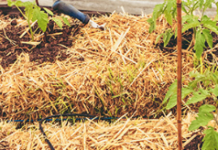Garden beds and borders, artfully filled with a colorful tapestry of flowers and foliage, are always in vogue. But unlike traditional English perennial beds and borders—which were labor intensive and peaked mainly in spring—today’s mixed gardens are filled with plants bred to perform better, require less care and offer a long season of interest.
Typically, low-maintenance designs combine tough, flowering perennials with hardy shrubs, bulbs, grasses and foliage plants, so a new twist on the basic look emerges each season.
To design (or redesign) a lower-maintenance bed or border, follow these tips from garden writer Doug Green and the man behind Anthony Tesselaar Plants.
1. Define the point of view. “Decide where you’re going to look at the garden the most,” said Green, author of douggreensgarden.com. “This is the point of view. In other words, (from this angle) you’re looking at the front of the garden.”
2. Spread the love. “The trick to having a garden that blooms all summer is to pick an equal amount of flowers for each of the three bloom periods,” Green continued. Choose plants that bloom in early, mid- and late summer. Then place them evenly throughout the garden, rather than clumping all the early bloomers at one end and the late bloomers at the other.
3. Add some shrubs. “I’m incorporating shrubs directly into all my borders now,” said Green. “In fact, one of my front beds is being designed and planted to be mostly shrubs and bulbs, with a few shrub roses and fall-blooming annuals for late-season color.”
4. Choose a range of plant heights. “Go tall in back, medium in the middle and low in the front,” said Anthony Tesselaar. “But don’t line them up like a school photo. Think overlapping drifts.”
5. Employ strong form and color. “One or two kinds are enough, and repeat them throughout the border,” said Tessellaar. “For instance, try the tall, broad-leaved, colorfully foliaged Tropicanna cannas for season-long interest and a dramatic effect that looks great in any combination of plants.” Agaves and fastigiate evergreens like ‘Sky Pencil’ holly are other choices with strong form.
6. Create a backdrop. “A tall flowering hedge at the back creates a canvas for the rest of your ‘art,'” said Tesselaar. He suggested the hybrid Magnolia Fairy Magnolia Blush, with its dark green, compact foliage and masses of russet spring buds that open to fragrant spring flowers. “Who wouldn’t love a fragrant flowering hedge to divide or frame garden spaces?” He added.
7. Include evergreen and long-blooming plants for year-round color and texture. “Festival Burgundy cordyline, for instance, has become a favorite with its cascading mass of grass-like, bright burgundy leaves spouting from a short central base,” Tesselaar suggested. Doug Green added tickseeds (Coreopsis), bellflowers (Campanula), chrysanthemums and Shasta daisies, blanketflower (Gaillardia) and daylilies for long bloom times.
8. Make it mower friendly. Add a mowing strip mourn the outside of the bed to make it easy to mow the lawn without having to work around the plants. This could be a strip of stones or bricks or a tight, low hedge of dwarf boxwood (Buxus) or sweet box (Sarcococca).
9. Invest in edging. “The use of landscape edging, if done properly, can reduce the time and effort any gardener takes to maintain the garden,” said Green. Plastic landscape edging can be a real time saver, he added, but cheaper isn’t better. Cheap edging is made of thinner plastic, which wears down quicker, and it is shorter in height, so there’s less material to sink into the ground, making it easier for grass roots to sneak underneath. Cheap edging often comes with fewer stakes to hold it in place and it bends easily—both of these details mean it’s more likely to pop out of the ground.
Recommended related reading:
In The Know Maintenance Perennial Garden, Roy Diblik explains how to design a garden with long seasons of interest and how maintaining it should entail just a couple of tasks per year. This book also includes specific plans for sun and shade gardens and profiles of individual species with recommended companions.
Learn more about creating interest across seasons from Doug Green, who is quoted in this article, with his book How to Design An Everblooming Garden.
Find plants and practices that can contribute to a downsized, low-maintenance yet endlessly gorgeous garden in The Right-size Flower Garden by Kerry Ann Mendez.




